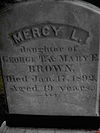
Mercy Brown vampire incident
Encyclopedia

Undead
Undead is a collective name for fictional, mythological, or legendary beings that are deceased and yet behave as if alive. Undead may be incorporeal, such as ghosts, or corporeal, such as vampires and zombies...
manifestation.
In Exeter, Rhode Island
Exeter, Rhode Island
Exeter is a town in Washington County, Rhode Island, United States. Exeter extends east from the Connecticut border to the town of North Kingstown. It is bordered to the north by West Greenwich and East Greenwich, and to the south by Hopkinton, Richmond and South Kingstown. Exeter's postal code...
, the family of George and Mary Brown suffered a sequence of tuberculosis
Tuberculosis
Tuberculosis, MTB, or TB is a common, and in many cases lethal, infectious disease caused by various strains of mycobacteria, usually Mycobacterium tuberculosis. Tuberculosis usually attacks the lungs but can also affect other parts of the body...
infections in the final two decades of the 19th century. Tuberculosis was called "consumption" at the time and was a devastating and much-feared disease.
The mother, Mary, was the first to die of the disease, followed in 1888 by their eldest daughter, Mary Olive. Two years later, in 1890, their son Edwin also became sick.
In 1891, another daughter, Mercy, contracted the disease and died in January 1892. She was buried in the cemetery of the Baptist Church in Exeter
Baptist Church in Exeter
The Baptist Church in Exeter, also known as Chestnut Hill Baptist Church, is an historic building located at 467 Ten Rod Road in Exeter, Rhode Island....
.
Friends and neighbors of the family believed that one of the dead family members was a vampire
Vampire
Vampires are mythological or folkloric beings who subsist by feeding on the life essence of living creatures, regardless of whether they are undead or a living person...
(although they did not use that name) and caused Edwin's illness. This was in accordance with threads of contemporary folklore linking multiple deaths in one family to undead activity. Consumption was a poorly understood condition at the time and the subject of much superstition.
George Brown was persuaded to exhume the bodies, which he did with the help of several villagers on March 17, 1892. While the bodies of both Mary and Mary Olive had undergone significant decomposition over the intervening years, the more recently buried body of Mercy was still relatively unchanged and had blood in the heart. This was taken as a sign that the young woman was undead and the agent of young Edwin's condition. The cold New England
New England
New England is a region in the northeastern corner of the United States consisting of the six states of Maine, New Hampshire, Vermont, Massachusetts, Rhode Island, and Connecticut...
weather made the soil virtually impenetrable, essentially guaranteeing that Mercy's body was kept in freezer-like conditions in an above-ground crypt during the 2 months following her death.
Mercy's heart was removed from her body, burnt, and the remnants mixed with water and given to the sick Edwin to drink. He died two months later.
Literature
The Mercy Brown incident was the inspiration for Caitlín R. KiernanCaitlin R. Kiernan
Caitlín Rebekah Kiernan is the author of many science fiction and dark fantasy works, including seven novels, many comic books, more than one hundred published short stories, novellas, and vignettes, and numerous scientific papers.- Overview :Born in Dublin, Ireland, she moved to the United States...
's short story, "So Runs the World Away," which makes explicit reference to the affair. It is also referred to in H. P. Lovecraft
H. P. Lovecraft
Howard Phillips Lovecraft --often credited as H.P. Lovecraft — was an American author of horror, fantasy and science fiction, especially the subgenre known as weird fiction....
's "The Shunned House
The Shunned House
"The Shunned House" is a short story by H. P. Lovecraft in the horror fiction genre. Written on October 16–19, 1924, it was first published in the October 1937 issue of Weird Tales.-Inspiration:...
". The story of Mercy also inspired Bram Stoker
Bram Stoker
Abraham "Bram" Stoker was an Irish novelist and short story writer, best known today for his 1897 Gothic novel Dracula...
to write Dracula
Dracula
Dracula is an 1897 novel by Irish author Bram Stoker.Famous for introducing the character of the vampire Count Dracula, the novel tells the story of Dracula's attempt to relocate from Transylvania to England, and the battle between Dracula and a small group of men and women led by Professor...
in which the character Lucy Westenra
Lucy Westenra
Lucy Westenra is a fictional character in the novel Dracula by Bram Stoker. She is the 19-year-old daughter of a wealthy family. Her father is not mentioned in the novel and her elderly mother is simply stated as being Mrs. Westenra. Lucy is introduced as Mina Murray's best friend. In the 1931...
is based on Mercy. Mercy Brown's story was the inspiration for a young adult novel, "Mercy: The Last New England Vampire" by Sarah L. Thomson.

